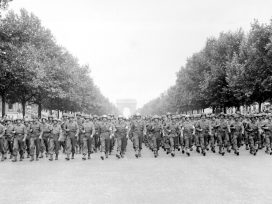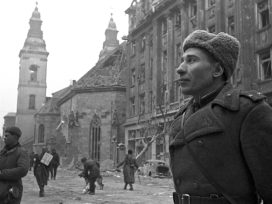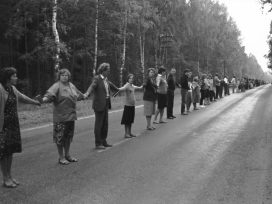“After the collapse of the great utopias that were at the core of the old missionary universalism of modernity, a new universalism of mourning patterns the public rituals of national identity – the victims assume the position that, before, was the place of heroes.”
Bernhard Giesen, Triumph and Trauma
In 2007 I happened to visit Chop (Hungarian: Czap), a small town with a sizable Hungarian minority on the western border of Ukraine. Founded in the late nineteenth century, it belonged to the Kingdom of Hungary until the First World War and then went to Czechoslovakia after the Trianon Treaty. In 1938 the Hungarian army, supported by Nazi Germany, occupied the town. After the Second World War Transcarpathia – including Chop, an important railway junction – became part of Soviet Ukraine. In the first post-war years, local Hungarians suffered a kind of collective punishment for having been on the “wrong side” during WWII. Former soldiers of the Hungarian army were put in Soviet detention camps in the Carpathian Mountains, the Hungarian intelligentsia and the Lutheran clergy suffered repressions, and young Hungarians were sent to the Donbas mines as forced labour instead of being drafted into the army. The Hungarian minority did not, however, become a subject to forced repatriation and was allowed to use its native language in education and local administration.
It was during my visit to Chop that I came across a monument dedicated to “the innocent victims of the Second World War” (the inscription was both in Hungarian and Ukrainian). The obvious dissonance between the fresh inscription and the monument’s Soviet style prompted me to ask my guide what it had been before. It turned out that the memorial was indeed constructed in Soviet times and dedicated to the heroes of the Hungarian Soviet Republic of 1919, to Béla Kun and his comrades. The Hungarian Soviet Republic lasted only four months, from 21 March until 1 August 1919, when it collapsed after Romanian forces occupied Budapest. Some Hungarian Communists were executed, others landed in exile in the USSR. In post-war Transcarpathia the myth of the Hungarian Soviet Republic of 1919 was used to integrate the local Hungarian minority into the Soviet project. The re-dedicated memorial in Chop represents a fading trace of these efforts. After 1989, the Hungarians, like other ethnic groups, created their own narrative of collective suffering during and after WWII. Today a memorial to the victims of the post-war repressions can be found in every Hungarian village in Transcarpathia.
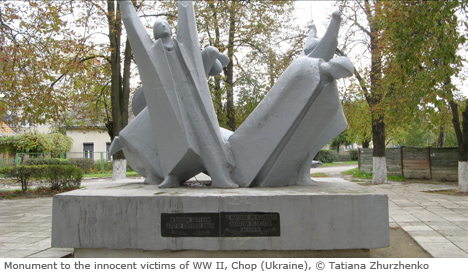 The fate of this monument is a good illustration of one of the great transformations of the last two decades: the disintegration of the Soviet commemorative culture and the emergence of the new, post-Soviet ones. One aspect of this transformation is the transition “from triumph to trauma”; in other words, a shift from the dominant narrative of heroic mass sacrifice and courage to multiple narratives of victimhood and suffering. This transformation is evident in most former Soviet republics, with the exception of Russia. Soviet heroes disappeared with the fall of “Stalin’s empire of memory” (Serhiy Yekelchyk). Even if some survived – such as the “Young Guard” underground fighters, whose cult has been supported by the local political elites in Ukrainian Luhansk – these are just fragments of the old grand narrative. Certainly, post-Soviet nation building requires new heroes and new heroic cults are emerging – such as that around the Ukrainian Insurgent Army in Ukraine. Yet there seems to be problems with the institutionalization of such heroic cults; narratives of suffering are politically more rewarding. Most post-Soviet states build their national identities on the notion of collective victimhood. Why is that the case? And why does Russia seem to be an exception to this rule?
The fate of this monument is a good illustration of one of the great transformations of the last two decades: the disintegration of the Soviet commemorative culture and the emergence of the new, post-Soviet ones. One aspect of this transformation is the transition “from triumph to trauma”; in other words, a shift from the dominant narrative of heroic mass sacrifice and courage to multiple narratives of victimhood and suffering. This transformation is evident in most former Soviet republics, with the exception of Russia. Soviet heroes disappeared with the fall of “Stalin’s empire of memory” (Serhiy Yekelchyk). Even if some survived – such as the “Young Guard” underground fighters, whose cult has been supported by the local political elites in Ukrainian Luhansk – these are just fragments of the old grand narrative. Certainly, post-Soviet nation building requires new heroes and new heroic cults are emerging – such as that around the Ukrainian Insurgent Army in Ukraine. Yet there seems to be problems with the institutionalization of such heroic cults; narratives of suffering are politically more rewarding. Most post-Soviet states build their national identities on the notion of collective victimhood. Why is that the case? And why does Russia seem to be an exception to this rule?
Heroism and suffering in Soviet narratives
In the Soviet era, official war narratives emphasized the heroism of Red Army soldiers and officers, as well as of the civil population resisting Nazi occupation and fighting on the “labour front”. Boris Dubin and Lev Gudkov have shown how the triumphalist narrative of the war created during the Brezhnev era helped legitimize the Soviet regime and consolidate the collective identity of the “Soviet people”. This triumphalist narrative was reflected in the Soviet war memorials erected not only in many Soviet cities but throughout Europe; these memorials had both commemorative and a geopolitical function. What was the relationship between triumph and trauma, heroism and suffering in Soviet commemorative culture? This is, of course, a universal issue, and has become one of the key questions in the history of the twentieth century. In his study of war memorials, Reinhart Koselleck asked how they help us make sense of human suffering. “The dead,” he wrote, “embody an exemplary status; they died for a reason, and survivors are supposed to find themselves in accord with this reason as not to allow the dead to have died in vain“. How, then, did the Soviet regime make sense of the immense human suffering and unprecedented death toll during WWII?
Not only were Soviet narratives of suffering secondary to heroic narratives, but they were also rather abstract: they constructed a single victim group, the “Soviet civilian population” suffering from Nazi brutalities. Speaking about particular groups of victims would have raised too many uncomfortable questions, would have challenged simple ideological constructions and created privileged groups in a society that was supposed to be monolithic. Those who failed to become heroes were denied a victim status – such as the Soviet war prisoners doomed to starvation in Nazi concentration camps. Their fate raised unpleasant questions about the disastrous strategic failures of the Soviet military, about the betrayal of millions of Soviet citizens by Stalin’s leadership and the deep mistrust of the regime towards those who had survived the Nazi camps. Official rhetoric often evoked the total number of the Soviet casualties at twenty million, but rarely concretized it. Media, literature and the arts avoided too much naturalism in portraying human suffering and brutalities of war. Such films as “Come and See” by Elem Klimov appeared only in the end of Soviet period, as the first symptoms of glasnost. During the Soviet era, the dominant narrative about Nazi occupation concentrated on Nazi crimes and not on people’s suffering.
Soviet commemorative culture required martyrs rather than victims – people who resisted and died for a purpose (underground fighters, partisans and their sympathizers). Passive victimhood or lack of resistance was considered akin to collaboration. The fact that millions of Soviet citizens had to live under Nazi occupation for two or three years, that in order to survive they had to work for and interact with the occupational regime, that they witnessed the deep humiliation of Soviet leaders and were exposed to Nazi propaganda and, finally, that the population had a chance to compare Soviet and Nazi policies on the everyday level – all this was very disturbing to the Soviet authorities. A regime that claimed absolute loyalty from its citizens had to supress the issue of mass collaboration with the Nazis (even if it was only passive). This side of wartime experience never became part of the mainstream narrative and remained locked in people’s private memories.
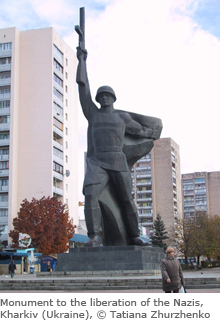 In short, spelling out suffering narratives was uncomfortable for the Soviet authorities since it might have raised question about the disastrous failures of the Soviet military leadership, the neglect of the needs of the civilian population, and might even have evoked parallels between Hitler’s and Stalin’s repressive policies. A good example of the repression of such narratives is the censorship of Babiy Yar, the documentary novel by Anatoli Kuznetzov, who as a child witnessed the horrors of WWII and the Nazi crimes in Kyiv. When the novel was published in 1966, fragments that could evoke parallels between the two regimes or testify to the recklessness and barbaric warfare methods of the Soviets were carefully removed. Also expunged were passages recalling the eagerness of the post-war Soviet authorities to erase the memory of the Babiy Yar massacre.
In short, spelling out suffering narratives was uncomfortable for the Soviet authorities since it might have raised question about the disastrous failures of the Soviet military leadership, the neglect of the needs of the civilian population, and might even have evoked parallels between Hitler’s and Stalin’s repressive policies. A good example of the repression of such narratives is the censorship of Babiy Yar, the documentary novel by Anatoli Kuznetzov, who as a child witnessed the horrors of WWII and the Nazi crimes in Kyiv. When the novel was published in 1966, fragments that could evoke parallels between the two regimes or testify to the recklessness and barbaric warfare methods of the Soviets were carefully removed. Also expunged were passages recalling the eagerness of the post-war Soviet authorities to erase the memory of the Babiy Yar massacre.
The example of Babiy Yar in Kyiv is paradigmatic of the Holocaust memory in the Soviet Union – or rather its absence. Efforts to memorialize the massacre of the Kyiv Jews were blocked by the Soviet authorities for decades; when a monument was finally erected, it did not mention the Jews but only the Soviet people. Another striking example is the fate of the Jewish Anti-fascist Committee and the Black Book initiated by Ilia Ehrenburg and Vassili Grossman, a compilation of eyewitness accounts about the killing of the Jews during the Nazi occupation of Soviet territories. The members of the Committee were repressed, some of them shot, and the book could only be published in Israel. One explanation for the Soviet suppression of the memory of the Holocaust can be found in Soviet nationalities policies. The only legitimate collective victim of war was the Soviet people; the official narrative carefully avoided constructing particular ethnic victim groups. Another reason was, however, the latent antisemitism of the Soviet authorities, which were perfectly aware of the popularity of “Judeo-Bolshevism” as a Nazi propaganda cliché and didn’t want the local population to associate the return of the Communists with pro-Jewish policies. While the Holocaust narrative was absent in the post-war Soviet Union, many Soviet Jews (especially those who had fought in the Red Army) had internalized the collective myth of the Great Patriotic War. Russian philosopher Mikhail Ryklin recently reflected on the difficulties post-Soviet Jewish immigrants in Germany have in integrating into local Jewish life. While members of the revived Jewish communities in Germany have built their identity on their descent from Holocaust victims and on Judaism, “the newcomers had other roots. The Holocaust, as it turned out, did not play a major role in their identity; its place was taken by the victory over Nazi Germany. In other words, those who came where not Jew-victims, but Jew-victors; and they became victors not as a separate group, not as an ethnos, but as a part of the ‘new historical entity’: the Soviet people.”
Another telling example of the ambivalent relationship between heroism and victimhood in the official Soviet narrative was the siege of Leningrad, where the unprecedented suffering of the city’s civil population was turned into a story of mass courage, endurance and patriotism. As Lisa A. Kirschbaum has demonstrated, while suffering was certainly an important part of the Soviet narrative of the siege, the Soviet narrative emphasized that “Leningraders were not passive victims, but active defenders” of the city. While it was difficult to avoid the subject of starvation, which was at the very core of the siege experience, certain aspects of it (such as the rumours about cannibalism) remained taboo. As Kirschbaum notes, “starving civilians […] stood not only as a potential reproach to the state, which lacked the means to feed them, but also as a potential challenge to the notion of heroic, meaningful, willing sacrifice”. Meaningless, dehumanizing and undignified suffering simply had no place in the Soviet narrative of the Great Patriotic War.
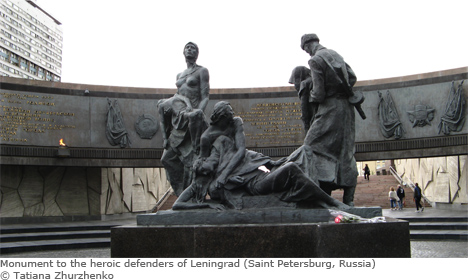 In her book Night of Stone: Death and Memory in Russia, Catherine Merridale asks how people dealt with suffering and death in a society that offered no public narratives to frame personal traumatic experience. The fact that only triumphalist, heroic war narratives were available in public meant that “people supressed, dismembered or distorted their memories and their grief where these did not fit the approved image, perhaps because they were Jews, perhaps because they had been on enemy territory, perhaps because of atrocities they had witnessed or even participated in”. Even more importantly, however, people preferred to see themselves as heroes rather than victims, making use of the dominant heroic meta-narrative. As Kirschbaum writes, “struggling to cope with painful memories and to endow tragedy with meaning, survivors often internalized, even if they did not completely accept, the state’s myths”. As long as the Soviet meta-narrative (and the Soviet state) existed, people’s lives and their suffering had sense.
In her book Night of Stone: Death and Memory in Russia, Catherine Merridale asks how people dealt with suffering and death in a society that offered no public narratives to frame personal traumatic experience. The fact that only triumphalist, heroic war narratives were available in public meant that “people supressed, dismembered or distorted their memories and their grief where these did not fit the approved image, perhaps because they were Jews, perhaps because they had been on enemy territory, perhaps because of atrocities they had witnessed or even participated in”. Even more importantly, however, people preferred to see themselves as heroes rather than victims, making use of the dominant heroic meta-narrative. As Kirschbaum writes, “struggling to cope with painful memories and to endow tragedy with meaning, survivors often internalized, even if they did not completely accept, the state’s myths”. As long as the Soviet meta-narrative (and the Soviet state) existed, people’s lives and their suffering had sense.
From triumph to trauma
Today we can observe the end of this narrative throughout more or less the whole of the post-Soviet space (except Russia). Even if it continues to exist in some contexts, and even if it is still popular among certain social groups and used by some political actors, this meta-narrative has lost its singular status and must now compete with alternative discourses about WWII. In post-Soviet societies, narratives of suffering now play a primary role, while heroic narratives have become secondary, fragmentary and ambivalent. What are the reasons for this shift?
In the last twenty years, what can be described as a “transition from triumph to trauma” has taken place in the post-Soviet space. This formula is borrowed from the German sociologist Bernhard Giesen, for whom this transition is a characteristic feature of European modernity in general. According to Giesen, “in modern western nations, the triumphalist founding myth is increasingly being replaced by reference to a traumatic past, to the collective memory of victims and perpetrators. New national memorials and museums rarely commemorate triumphant victories, but recall the victims of the past.”
Giesen’s formula resonates with the provocative ideas of Andreas Huyssen, for whom “the emergence of memory as a key concern in western societies, a turning towards the past […] stands in stark contrast to the privileging of the future so characteristic of the previous decades of twentieth century modernity”. The ambitious project of modernity required a hero as a model for identification; communism, with its triumphalist pathos, was part of this future-oriented endeavour. In contrast, post-modern western societies, having embarked on taking responsibility for the past, are concerned with victims and, to a lesser extent, perpetrators. The figure of the hero has become not only redundant but morally suspicious.
The Soviet “empire of memory” was an integral part of the Cold War geopolitical order and it is no surprise that it collapsed along with that order. As Jan Werner Müller has written, after 1989 “memories of the Second World War were ‘unfrozen’ on both sides of the former Iron Curtain [….] liberated from constraints imposed by the need for state legitimation and friend-enemy thinking associated with the Cold War”. The disintegration of the Soviet bloc (and later the USSR) might even to some extent have been a result of the subversive victimhood narratives entering the public space as well as domestic and international politics. Think about the narratives of the Katyn massacre and of the Great Famine, which undermined the legitimacy of the Soviet regime at the end of perestroika. Or consider the Baltic republics, where demands to reveal the truth about the Molotov-Ribbentrop pact and the new meta-narratives on Soviet deportations and repressions helped restore and legitimize national independence. One can find many explanations of the Soviet collapse in academic literature, but one is rarely discussed: the Soviet empire collapsed under the burden of historical guilt. If narratives of suffering proved to be so effective in dissolving the Soviet empire and enabling the former Soviet republics to achieve national independence, no wonder that political actors still find them still useful today – for example, in containing Russia’s geopolitical ambitions in eastern Europe.
But the rise of the victimhood narratives in the post-Soviet space has yet another dimension. It is inspired and fuelled by a new global moral culture and politics of human rights, themselves connected to the universalization of Holocaust memory. Giving voice to the victims of repressions and violence has become a moral imperative, the core of our understanding of historical justice. We now assume that articulating memories of suffering has a therapeutic effect not only on individuals but also on collectives, and that overcoming “collective amnesia” improves the moral qualities of society. Not only are victims’ voices welcomed and encouraged, victims’ perspectives of historical events are often presented as the only moral and therefore legitimate ones. The argument that, from a victim’s point of view, Communism and Nazism were equally criminal, and that both regimes and even ideologies were therefore similar, remains controversial. Nevertheless, it is finding growing acceptance. It is this perspective that inspired the establishment of a European Day of Remembrance for the victims of all totalitarian and authoritarian regimes in 2009.
Nation builders in the post-Soviet space also seem to prioritize victims over heroes. With the exception of Russia, post-Soviet nation building is based on post-colonial narratives of collective victimhood that allow the externalization of communism as an occupational regime and present the nation as a victim of both Stalin and Hitler. While new national heroes have undoubtedly been created in post-Soviet states, heroic narratives are less useful in democratic, free-market societies that do not require mass mobilization and total ideological control. More importantly still, new heroic narratives are inevitably particularistic and can therefore be contested by competing ethnic and social groups. National minorities often have their own collective memories of WWII and the new heroes of the titular nation are not automatically accepted by the population as a whole. Regional differences in commemorative cultures also play a role – think of Roman Shukhevych and Stepan Bandera, the leaders of the Ukrainian Insurgent Army (UPA). There is a genuine popular cult of the UPA heroes in western Ukraine and its political relevance is growing in response to the allegedly pro-Russian politics of the Kyiv government. At the same time, the attempts of the former president Viktor Yushchenko to institutionalize this cult at the national level polarized the country and complicated Ukraine’s relations with Russia, Poland and the EU.
Reconciliation or memory wars?
But do narratives of suffering unite or rather divide? Do they reconcile former enemies and overcome hostilities or, on the contrary, provide an additional opportunity to articulate these? The answer is that it depends on who uses these narratives and to what political purpose. In the post-communist countries, liberalization opened the way for old-new “communities of suffering” and their institutionalization: war veterans of different armies and military formations, former expellees and refugees, victims of political repressions, “freedom fighters” and their “victims”, many of these groups tending to be nationalist and xenophobic. These new “commemorative entrepreneurs” are often well organized and highly mobilized, even if they do not enjoy serious political influence. The various narratives of suffering are often directed against each other; their representatives try to contest a common public space and to exclude one another. Nationalists (and often nation builders, too) claim a monopoly on suffering, ignoring other groups. The plurality of victims groups and their narratives of suffering can be easily turned into a “competition among victims”, as the case of Babiy Yar demonstrates, which is a Holocaust site and at the same time a fraternal grave for many other groups of victims.
In contrast to nationalists, liberals see in victimhood narratives a potential for reconciliation. This is especially visible in Ukrainian-Polish relations: the liberal intelligentsia of both countries, in their struggle against radical Ukrainian and Polish nationalisms (as well as neo-Stalinism in Ukraine), attempt to re-narrate WWII and the Polish-Ukrainian conflict as a tragedy of common suffering under Hitler and Stalin. The critical assessment of the Molotov-Ribbentrop pact, the interpretation of the Soviet invasion in eastern Galicia as “aggression” and “occupation”, and the condemnation of both Nazism and Stalinism have become important elements of Polish-Ukrainian reconciliation. The benefit of the “we all are victims” formula is its inclusive and non-discriminatory character, allowing both sides to downplay conflicting ethnic narratives of collective suffering.
Ukrainian historian Yaroslav Hrytsak, one of the ideologists of Ukrainian-Polish reconciliation, is representative of this approach. He also offers it as a solution for internal Ukrainian conflicts over historical memory. Asked by journalists in the wake of this year’s Victory Day if a single Ukrainian narrative on WWII was possible, he answered:
In Second World War, Ukraine was united by victims and not by heroes. The main lesson of those events is that Ukraine is not a territory that other powers can use for their interests. Our country paid a very high price for this lesson: from the beginning of WWI to the end of WWII, every second man and every fourth woman died. It is clear that we cannot build history on victims only, we also need heroes. In my view, we should consider heroes those people who took the victims’ side”.
The narrative of WW II history preferred by former president Yushchenko presented the Ukrainian nation as a victim of two totalitarian regimes. At the start of his presidency he also promoted the idea of reconciliation between Soviet and UPA veterans. According to Sofia Grachova, “the new official historical narrative represented the war not so much as a glorious event, but rather as a terrible tragedy that struck the Ukrainian people in the absence of a national state”. However, Yushchenko’s idea did not meet with much enthusiasm on either side. As his popular support rapidly declined, he started appealing to the conservative and rightwing strata of Ukrainian society by forging a new cult of national heroes around the UPA.
Soviet veterans have also clung to the traditional heroic narrative of the Great Patriotic War, and there is little chance of their being convinced that they were merely Stalin’s victims. There seems to be a fundamental problem with the “we all are victims” formula: the role of a victim denies individual self-determination and historical agency, the things that endow human life with meaning. And while liberal intellectuals increasingly look back to WWII in Ukraine as a tragic fraternal conflict without winners, this narrative will hardly become common ground for national reconciliation in Ukraine in the near future. Even more complex is the issue of historical justice, since the narrative of collective victimhood helps externalize guilt and responsibility: if everybody is a victim, it makes no sense any more to speak about perpetrators.
The (not so) special case of Russia
How specific is the case of Russia, where the traditional state-endorsed triumphalist narrative of WWII still dominates, and even constitutes, the foundations of national identity? There is nothing surprising in the fact that Russia, as a successor state of the Soviet Union, claims the Great Patriotic War as its most important symbolic legacy. As Boris Dubin has pointed out, once the October Revolution, socialism and the USSR had lost their symbolic value, the role of the Soviet Union in defeating fascism became its only uncontroversial contribution to world history. There is, of course, a geopolitical dimension to this triumphalist narrative: the “great victory over fascism” became the Soviet Union’s entry ticket to the club of world powers and legitimized its new global status and sphere of influence on the European continent. Like the USSR, post-Soviet Russia draws its geopolitical status from the outcome of WWII.
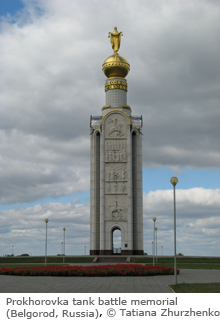 And yet, certain developments in post-Soviet Russia testify to the universality of the “transition from triumph to trauma”. One is the religious renaissance and new role of the Russian Orthodox Church. Soviet culture, future-oriented and secular as it was, lacked the symbolic language and rituals for expressing suffering and for mourning the victims of war and political repression. By providing people with a space for commemoration and the expression of private grief, the Russian Orthodox Church assumed an important social function. Moreover, by contributing to the construction of a new narrative of Russian victimhood, the Church became a key actor in memory politics. The political implications of this new role are ambivalent as far as the legacy of Stalinism is concerned. First, the Church presents itself as the primary victim of Communist repressions and thus claims a special status in Russian society. Second, since the Church now takes responsibility for mourning the victims of Stalinism, the state and the public feel no urge to seriously engage in this issue. As a result, the issue of guilt and responsibility is virtually absent in the new discourse on Russian victimhood. Third, the Church has not abandoned the triumphalist narrative; quite the opposite, it actively participates in constructing a new narrative of Russian military glory and strong Russian statehood. Lastly, the narrative of Russian victimhood, as it is used by the Orthodox Church, is easily instrumentalized by Russian nationalism for excluding and silencing other “communities of suffering”.
And yet, certain developments in post-Soviet Russia testify to the universality of the “transition from triumph to trauma”. One is the religious renaissance and new role of the Russian Orthodox Church. Soviet culture, future-oriented and secular as it was, lacked the symbolic language and rituals for expressing suffering and for mourning the victims of war and political repression. By providing people with a space for commemoration and the expression of private grief, the Russian Orthodox Church assumed an important social function. Moreover, by contributing to the construction of a new narrative of Russian victimhood, the Church became a key actor in memory politics. The political implications of this new role are ambivalent as far as the legacy of Stalinism is concerned. First, the Church presents itself as the primary victim of Communist repressions and thus claims a special status in Russian society. Second, since the Church now takes responsibility for mourning the victims of Stalinism, the state and the public feel no urge to seriously engage in this issue. As a result, the issue of guilt and responsibility is virtually absent in the new discourse on Russian victimhood. Third, the Church has not abandoned the triumphalist narrative; quite the opposite, it actively participates in constructing a new narrative of Russian military glory and strong Russian statehood. Lastly, the narrative of Russian victimhood, as it is used by the Orthodox Church, is easily instrumentalized by Russian nationalism for excluding and silencing other “communities of suffering”.
But it is not only the Russian Orthodox Church that promotes a narrative of suffering. The Russian liberal milieu, the pro-Western part of civil society, and even a part of the political elites have discovered the narrative of the Russian nation as victim of Stalinism. Interesting in this respect is the draft of a national programme entitled “On commemorating the victims of the totalitarian regime and on national reconciliation”, prepared by the Working Group on Historical Memory at the Presidential Council on the Development of Civil Society and Human Rights. Drafted in spring 2008, the programme reflects the hopes for democratization placed in President Medvedev. As is evident from its title, the programme’s main accent is on commemorating victims and on reconciliation, rather than on transitional justice. It underlines the need for Russia to face its past as a precondition for successful modernization. It also has a chapter on international politics, suggesting common initiatives for the prevention of memory wars in the post-Soviet space and eastern Europe and reconciliation according to the “we all are victims” formula. Also interesting are comments by one of the main authors of the document, the head of the Working Group on Historical Memory Sergey Karaganov, published in Rossiyskaya Gazeta. Karaganov uses the term “self-genocide” in relation to the Russian nation, for example. At the same time, he is concerned with restoring the national pride and does not reject the triumphalist narrative completely, but proposes to give a proper place to the victims. Given recent political developments in Russia, the future of the programme does not look bright. Still, the document is exemplary of the liberal victimhood discourse supported in Russia today by various political actors. One could argue, then, that Russia is not an exception to the tendency of “transition from triumph to trauma” characteristic of European modernity.
“You are what your grandparents suffered”
In his book The Memory Chalet, Tony Judt reflects on the implication of what he calls the “communitarian solipsism” in American society:
Most people no longer speak the language of their forebears or know about their country of origin, especially if their family started out in Europe. But in the wake of a generation of boastful victimhood, they wear what little they do know as a proud badge of identity: you are what your grandparents suffered.
Judt was above all referring to the Jewish diaspora. But his formula of contemporary identity politics might also apply to the post-Soviet world. So let me add one more explanation for the “transition from triumph to trauma” – generational change. Here there is an interesting paradox: the generation of parents and grandparents, those who suffered in the WWII and from the mass repressions before and after, and who lost loved ones, often still cling to the Soviet narratives of endurance and courage that gave meaning to their lives. It is their children and grandchildren who now embrace the new narratives of suffering and collective victimhood, despite the fact that they hardly experienced the traumatic events themselves.
This essay is based on a presentation given at the international symposium “Narratives of Suffering in Post-Cold War Europe: the Second World War in Transnational Contexts”, held at the Aleksanteri Institute, University of Helsinki on 3-4 September 2012.

 The fate of this monument is a good illustration of one of the great transformations of the last two decades: the disintegration of the Soviet commemorative culture and the emergence of the new, post-Soviet ones. One aspect of this transformation is the transition “from triumph to trauma”; in other words, a shift from the dominant narrative of heroic mass sacrifice and courage to multiple narratives of victimhood and suffering. This transformation is evident in most former Soviet republics, with the exception of Russia. Soviet heroes disappeared with the fall of “Stalin’s empire of memory” (Serhiy Yekelchyk). Even if some survived – such as the “Young Guard” underground fighters,
The fate of this monument is a good illustration of one of the great transformations of the last two decades: the disintegration of the Soviet commemorative culture and the emergence of the new, post-Soviet ones. One aspect of this transformation is the transition “from triumph to trauma”; in other words, a shift from the dominant narrative of heroic mass sacrifice and courage to multiple narratives of victimhood and suffering. This transformation is evident in most former Soviet republics, with the exception of Russia. Soviet heroes disappeared with the fall of “Stalin’s empire of memory” (Serhiy Yekelchyk). Even if some survived – such as the “Young Guard” underground fighters, In short, spelling out suffering narratives was uncomfortable for the Soviet authorities since it might have raised question about the disastrous failures of the Soviet military leadership, the neglect of the needs of the civilian population, and might even have evoked parallels between Hitler’s and Stalin’s repressive policies. A good example of the repression of such narratives is the censorship of Babiy Yar, the documentary novel by Anatoli Kuznetzov, who as a child witnessed the horrors of WWII and the Nazi crimes in Kyiv. When the novel was published in 1966, fragments that could evoke parallels between the two regimes or testify to the recklessness and barbaric warfare methods of the Soviets were carefully removed. Also expunged were passages recalling the eagerness of the post-war Soviet authorities to erase the memory of the Babiy Yar massacre.
In short, spelling out suffering narratives was uncomfortable for the Soviet authorities since it might have raised question about the disastrous failures of the Soviet military leadership, the neglect of the needs of the civilian population, and might even have evoked parallels between Hitler’s and Stalin’s repressive policies. A good example of the repression of such narratives is the censorship of Babiy Yar, the documentary novel by Anatoli Kuznetzov, who as a child witnessed the horrors of WWII and the Nazi crimes in Kyiv. When the novel was published in 1966, fragments that could evoke parallels between the two regimes or testify to the recklessness and barbaric warfare methods of the Soviets were carefully removed. Also expunged were passages recalling the eagerness of the post-war Soviet authorities to erase the memory of the Babiy Yar massacre. In her book Night of Stone: Death and Memory in Russia, Catherine Merridale asks how people dealt with suffering and death in a society that offered no public narratives to frame personal traumatic experience.
In her book Night of Stone: Death and Memory in Russia, Catherine Merridale asks how people dealt with suffering and death in a society that offered no public narratives to frame personal traumatic experience. And yet, certain developments in post-Soviet Russia testify to the universality of the “transition from triumph to trauma”. One is the religious renaissance and new role of the Russian Orthodox Church. Soviet culture, future-oriented and secular as it was, lacked the symbolic language and rituals for expressing suffering and for mourning the victims of war and political repression. By providing people with a space for commemoration and the expression of private grief, the Russian Orthodox Church assumed an important social function. Moreover, by contributing to the construction of a new narrative of Russian victimhood, the Church became a key actor in memory politics. The political implications of this new role are ambivalent as far as the legacy of Stalinism is concerned. First, the Church presents itself as the primary victim of Communist repressions and thus claims a special status in Russian society. Second, since the Church now takes responsibility for mourning the victims of Stalinism, the state and the public feel no urge to seriously engage in this issue. As a result, the issue of guilt and responsibility is virtually absent in the new discourse on Russian victimhood. Third, the Church has not abandoned the triumphalist narrative; quite the opposite, it actively participates in constructing a new narrative of Russian military glory and strong Russian statehood. Lastly, the narrative of Russian victimhood, as it is used by the Orthodox Church, is easily instrumentalized by Russian nationalism for excluding and silencing other “communities of suffering”.
And yet, certain developments in post-Soviet Russia testify to the universality of the “transition from triumph to trauma”. One is the religious renaissance and new role of the Russian Orthodox Church. Soviet culture, future-oriented and secular as it was, lacked the symbolic language and rituals for expressing suffering and for mourning the victims of war and political repression. By providing people with a space for commemoration and the expression of private grief, the Russian Orthodox Church assumed an important social function. Moreover, by contributing to the construction of a new narrative of Russian victimhood, the Church became a key actor in memory politics. The political implications of this new role are ambivalent as far as the legacy of Stalinism is concerned. First, the Church presents itself as the primary victim of Communist repressions and thus claims a special status in Russian society. Second, since the Church now takes responsibility for mourning the victims of Stalinism, the state and the public feel no urge to seriously engage in this issue. As a result, the issue of guilt and responsibility is virtually absent in the new discourse on Russian victimhood. Third, the Church has not abandoned the triumphalist narrative; quite the opposite, it actively participates in constructing a new narrative of Russian military glory and strong Russian statehood. Lastly, the narrative of Russian victimhood, as it is used by the Orthodox Church, is easily instrumentalized by Russian nationalism for excluding and silencing other “communities of suffering”.

